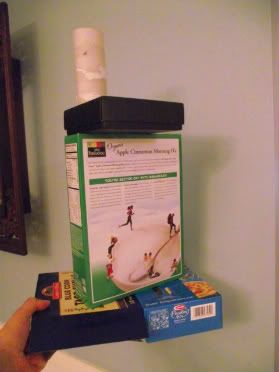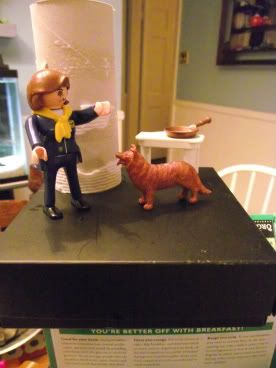Last week, when I picked T. up from school, she pointed out several kids who were carting off huge cardboard structures made from boxes and toilet paper roll tubes.
"Do you see those?" She asked me. "Some of the kids got to make them in math class."
I sprang to attention. "Some kids?"
Other kids, in some other math group, apparently. All the first graders are studying three-dimensional shapes--cubes, cylinders, rectangles, and working closely on graphing and charting the different types of shapes.
I tried to probe further--which kids? When? In whose class? But then I let the matter drop. It seemed silly to relentlessly pursue the point, but I was still a little bothered inside by the fact that T.'s math group didn't get that hands-on learning opportunity. It reminded me of L.'s entire 3rd grade year, in fact, when the other classes got to do all sorts of interesting enrichment projects and activities and L.'s class stuck to curriculum and to EOG (end-of-grade) test prep.
Clearly the wounds run deep (I'm still carrying a torch for that whole math stars business).
T. was disappointed that she hadn't been able to do the project in her math group, so I promised her that we would work on our own 3-D shapes project that very weekend. It's not difficult to do these extra, learning-based projects at home--all you need is your imagination and/or maybe even an internet connection, but whenever I find myself compensating for something I feel one of my children isn't getting at school, I can't help but think about the kids who aren't getting hands-on learning opportunities at home, either; the kids who count on school for those types of things and, if they're not getting them at school and they're not getting them at home, they're not getting them at all.
We gathered cereal boxes and toilet paper roll tubes, and found some neat foam-like inserts from a package of ice cream cones. I lined the table with paper and gave T. a bottle of glue. She happily worked for almost 45 minutes, assembling the different shapes into a structure she called a "box palace."


We looked for cylinders and cones and rectangles, and we talked about how we could find all those shapes all over the house, and in architecture, too. Then T. grew tired of the math angle and broke out some plastic Playmobil figures to inhabit the box castle and, suddenly, it was about so much more than mere shapes.

All this reminded me of the three weeks we spent in Greece, when L. was five and T. two. The only toys we brought with us were some matchbox cars, crayons, ColorWonder books, and a few plastic dolls for T. One hot, hot afternoon in Athens, when the sun had enveloped almost everything in the apartment, L. and my dad made a ferry boat entirely out of cardboard from leftover Ikea boxes and tape. It had a working gangplank for the cars to drive up, and a hollow inside where they could park for the crossing. L. played with the boat for hours every day we were there, and I when I think about all the toys that have stood the test of time in my own memory I think of that one--because it was truly born of the imagination, crafted by L.'s small fingers, and my dad's stronger ones. The night before we left we put the boat away into one of the closets, where L. hoped he would find it again one day; never imagining, I'm sure, that it would be years before we'd see it again.
I'll have to ask my parents if it's still there, stashed in a bedroom closet in that little Athens apartment.
I hope it is.